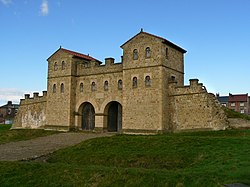
Summary
The Portgate was a fortified gateway, constructed as part of Hadrian's Wall where it crossed the Roman road now known as Dere Street, which preceded Hadrian's Wall by around 50 years. It was built to control traffic along Dere Street as it passed north through Hadrian's Wall. The gate's remains exist beneath the old B6318 Military Road to the south-west of the Stagshaw Roundabout (the B6318 was diverted slightly for the construction of the Stagshaw Roundabout, leaving two short sections of the existing road unlinked – the remains of the Portgate are buried beneath the western section).[1]
| Portgate | |
|---|---|
| Northumberland, England, UK | |
 Although the structure of the Portgate is unknown, it is likely to have resembled this reconstruction gateway at Arbeia | |
 Portgate Location in Northumberland | |
| Coordinates | 55°00′46″N 2°01′18″W / 55.012663°N 2.021612°W |
| Grid reference | NY98736869 |

Origins of the name edit
If any name was given to the structure by the Romans, it is no longer known. The name Portgate is thought to be of Anglo-Saxon origin.
Construction edit
The Portgate was constructed from very large masonry blocks. It projected between 3.06 metres (10.0 ft) and 3.66 metres (12.0 ft) north of the wall, sitting astride the wall. It was probably a square or rectangular structure.[2]
Excavations and investigations edit
- 1732 - John Horsley reported visible remains of a fortification at the location, stating[3]
There has been a square castellum, half within the wall and half without. There is a suggestion even today that the ditch of the wall turned northward round such a building.
- 1955 - English Heritage Field Investigation. It was noted that to the east of Dere Street there is a suggestion that the ditch turned north and followed the road for a short distance, however it is probable that this effect is due to contemporary drainage ditches.
- 1966 - Excavation directed by Miss D. Charlesworth exposed the west tower of the Portgate in the verge a few inches North of the kerb of the B6318.[4]
Civil parish edit
Portgate was a civil parish, in 1951 the parish had a population of 52.[5] Portgate was formerly a township in St. John-Lee parish,[6] from 1866 Portgate was a civil parish in its own right until it was abolished on 1 April 1955 and merged with Corbridge.[7]
Monument records edit
| Monument | Monument Number | English Heritage Archive Number |
| Portgate | 181662 | NY 96 NE 5 |
References edit
- ^ "Portgate". Pastscape. English Heritage. Archived from the original on 10 March 2012. Retrieved 26 August 2010.
- ^ Breeze, David J (1934), Handbook to the Roman Wall (14th Revised edition - Nov 2006), Society of Antiquaries of Newcastle upon Tyne, p. 184, ISBN 0-901082-65-1
- ^ Horsley, John (1732), Britannia Romana or the Roman Antiquities of Britain, Frank Graham (published 1974), ISBN 0-85983-090-X
- ^ The Journal of Roman Studies. 57. London: Society for Promotion of Roman Studies: 177. 1967.
{{cite journal}}: Missing or empty|title=(help) - ^ "Population statistics Portgate Tn/CP through time". A Vision of Britain through Time. Retrieved 24 January 2022.
- ^ "History of Portgate, in Tynedale and Northumberland". A Vision of Britain through Time. Retrieved 24 January 2022.
- ^ "Relationships and changes Portgate Tn/CP through time". A Vision of Britain through Time. Retrieved 24 January 2022.


